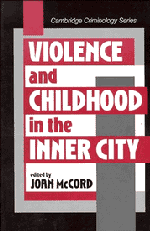Book contents
- Frontmatter
- Contents
- List of Contributors
- Preface
- 1 Violence and the Inner-City Street Code
- 2 The Embeddedness of Child and Adolescent Development
- 3 Placing American Urban Violence in Context
- 4 Neuropsychology, Antisocial Behavior, and Neighborhood Context
- 5 Psychological Mediators of Violence in Urban Youth
- 6 Understanding and Preventing Child Abuse in Urban Settings
- 7 Intervening to Prevent Childhood Aggression in the Inner City
- Name Index
- Subject Index
3 - Placing American Urban Violence in Context
Published online by Cambridge University Press: 01 June 2011
- Frontmatter
- Contents
- List of Contributors
- Preface
- 1 Violence and the Inner-City Street Code
- 2 The Embeddedness of Child and Adolescent Development
- 3 Placing American Urban Violence in Context
- 4 Neuropsychology, Antisocial Behavior, and Neighborhood Context
- 5 Psychological Mediators of Violence in Urban Youth
- 6 Understanding and Preventing Child Abuse in Urban Settings
- 7 Intervening to Prevent Childhood Aggression in the Inner City
- Name Index
- Subject Index
Summary
American cities are more violent than those in other developed nations. This chapter focuses on understanding the high degree of urban violence in terms of American history, public policies, and national culture. The chapter also presents information relevant to understanding dimensions of urban violence – where it occurs, by whom, and against whom. The discussion describes how rates of violence reflect political decisions about whom to count as victims and what to count as crimes. The core of the chapter considers macrolevel explanations for violence in urban America. It explains why American cities have high rates of violence but not why particular city dwellers contribute to violence.
Claims that the frontier ethic or immigrants account for America's violence are rebutted. I argue that cultural conditions and historical pressures have strong – and underappreciated – explanatory roles to play in unearthing the causes of violence in American cities.
Many types of violence have been considered acceptable throughout the history of the United States. Violence has been used by the powerful to protect their interests, and violence has been used by the less powerful when peaceful methods of persuasion failed. Violence has also been used simply for pleasure.
In the United States, the historical record also includes persistently discriminatory policies that have isolated poor blacks in cities. Despite the democratic promise of equality, for many American urban blacks discriminatory policies have blocked opportunities for legitimate success.
- Type
- Chapter
- Information
- Violence and Childhood in the Inner City , pp. 78 - 115Publisher: Cambridge University PressPrint publication year: 1997
- 25
- Cited by



